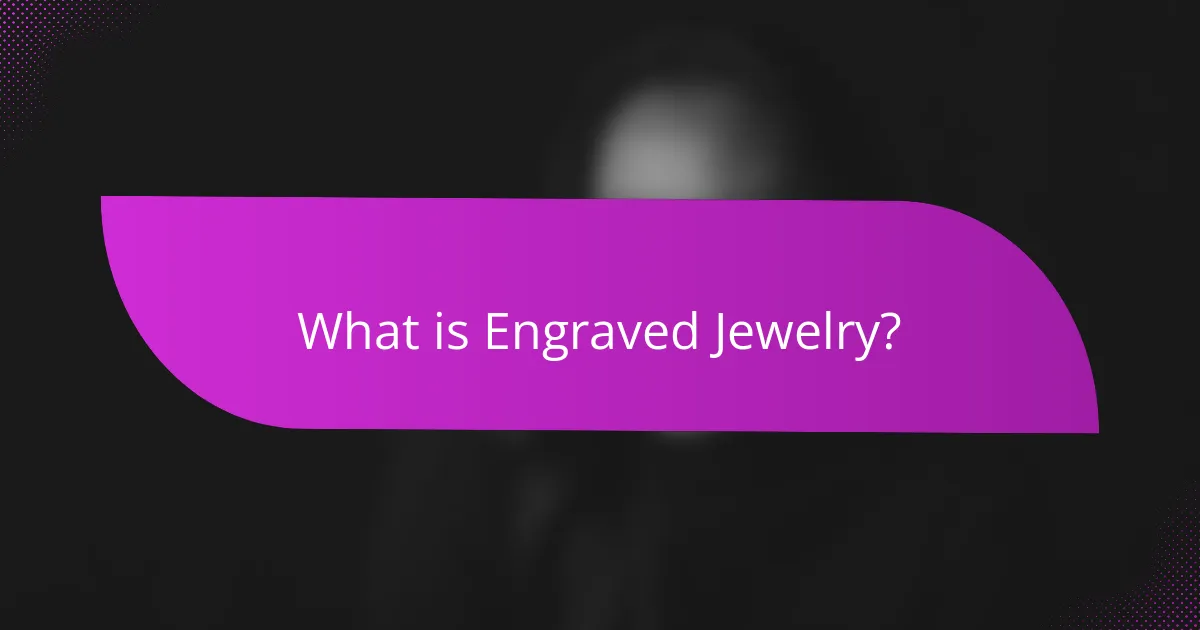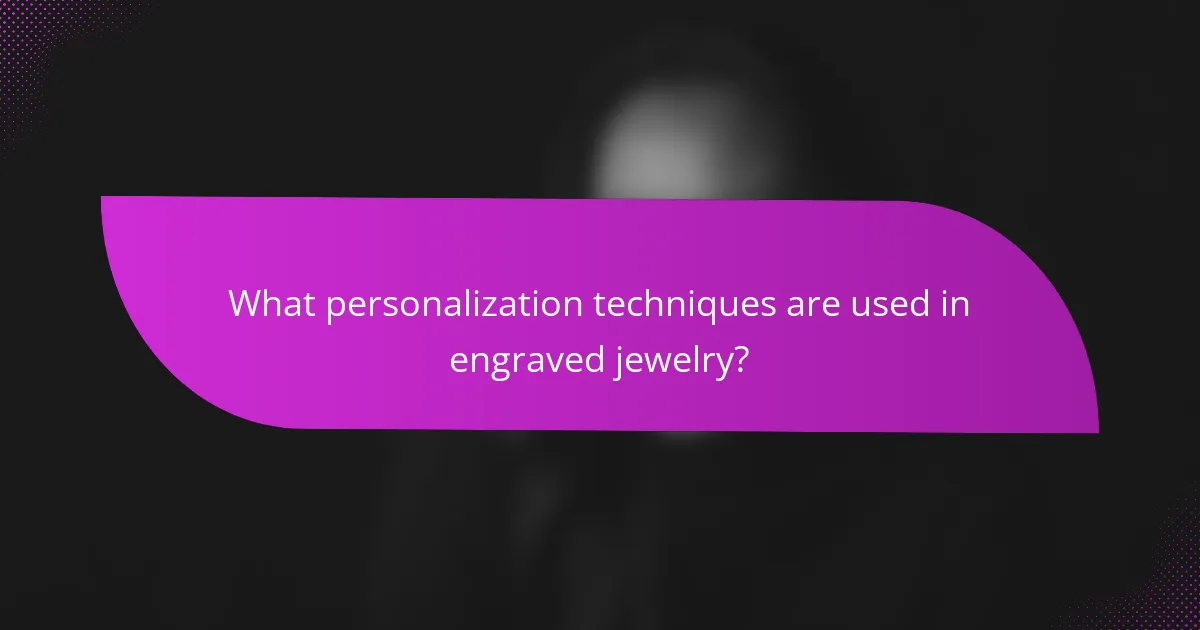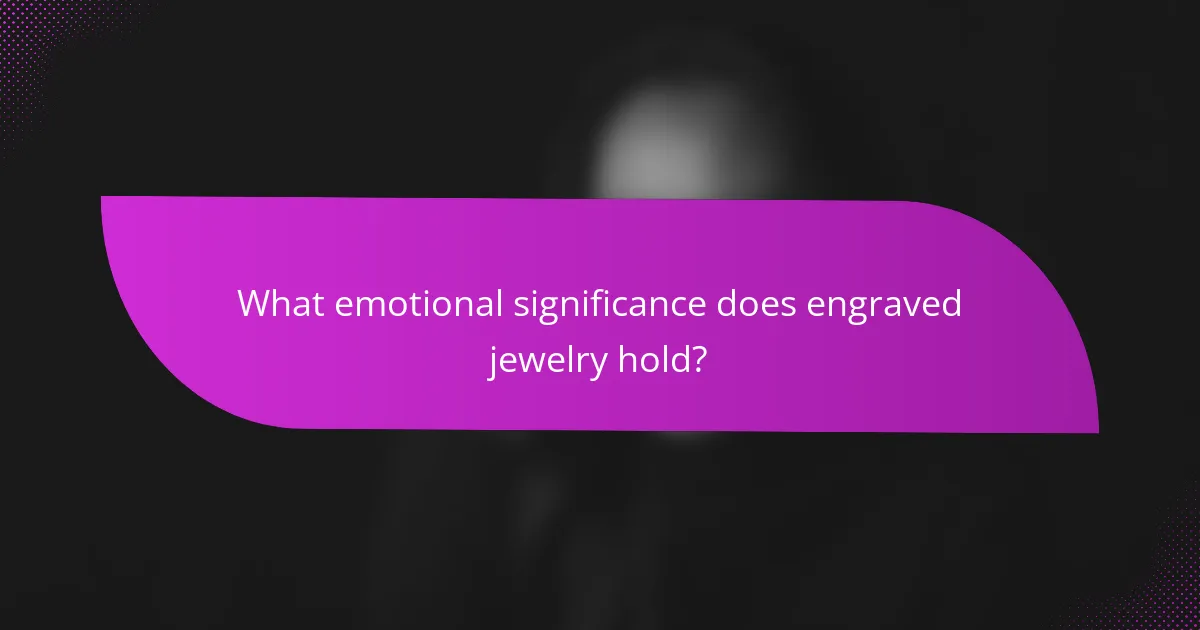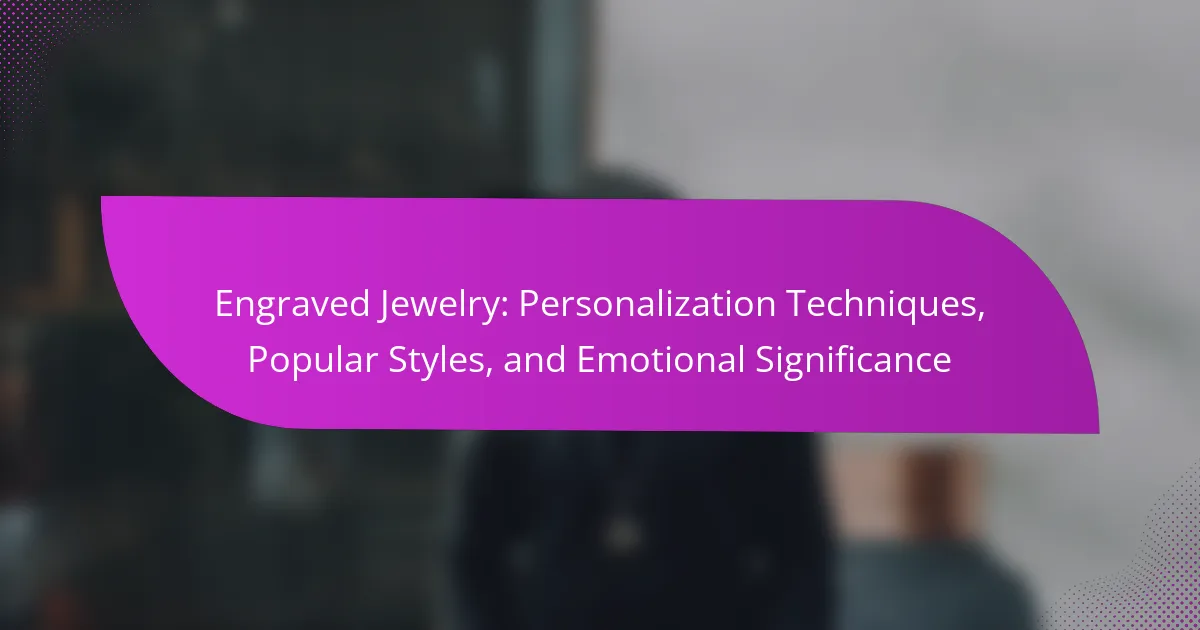Engraved jewelry is a personalized form of adornment that features inscriptions or designs carved into its surface, including items such as rings, necklaces, and bracelets. This jewelry often commemorates significant life events like weddings, anniversaries, or graduations, fostering emotional connections between the piece and the wearer. Various personalization techniques, such as laser engraving, hand engraving, and photo engraving, allow for unique designs that enhance the sentimental value of each item. The emotional significance of engraved jewelry lies in its ability to symbolize personal connections and memories, making it a cherished keepsake that reinforces bonds between individuals.

What is Engraved Jewelry?
Engraved jewelry is jewelry that features personalized inscriptions or designs carved into its surface. This type of jewelry can include rings, necklaces, bracelets, and more. The engraving can consist of names, dates, quotes, or symbols that hold personal significance. Engraved jewelry is often used to commemorate special occasions such as weddings, anniversaries, or graduations. Its popularity stems from the emotional connection it fosters between the piece and the wearer. Many people choose engraved jewelry as a meaningful gift for loved ones. The craftsmanship involved in engraving can vary, ranging from simple text to intricate designs. This customization adds a unique touch that mass-produced jewelry lacks.
How is engraved jewelry created?
Engraved jewelry is created through a process that involves several steps. First, the jewelry piece is selected, which can be made of various materials like gold, silver, or stainless steel. Next, the design or text to be engraved is chosen. This can include names, dates, or symbols.
The engraving is typically performed using one of two methods: laser engraving or hand engraving. Laser engraving uses a focused beam of light to etch the design onto the surface. This method allows for high precision and intricate details. Hand engraving, on the other hand, involves using specialized tools to carve the design manually.
After engraving, the piece may undergo polishing to enhance its finish. The final product is then inspected for quality before being presented to the customer. This process ensures that engraved jewelry is both personalized and aesthetically pleasing.
What materials are commonly used for engraving jewelry?
Common materials used for engraving jewelry include gold, silver, platinum, and stainless steel. Gold is popular due to its malleability and resistance to tarnish. Silver is favored for its affordability and bright finish. Platinum is chosen for its durability and hypoallergenic properties. Stainless steel is valued for its strength and corrosion resistance. Each material offers unique engraving possibilities, enhancing the jewelry’s personalization.
What techniques are employed in the engraving process?
Engraving techniques include laser engraving, rotary engraving, and hand engraving. Laser engraving uses a focused laser beam to etch designs onto the surface. This method allows for high precision and intricate details. Rotary engraving employs a rotating tool to carve into the material. It is commonly used for deeper engravings. Hand engraving involves manually carving designs using specialized tools. This technique offers a personal touch and unique artistry. Each engraving method can be used on various materials, including metal, wood, and glass. The choice of technique often depends on the desired effect and material type.
Why is personalization important in jewelry?
Personalization is important in jewelry because it enhances emotional connection and individuality. Customized pieces reflect personal stories and significant life events. They allow wearers to express their unique identities and values. Personalized jewelry often becomes cherished heirlooms, creating lasting memories. According to a survey by The Knot, 80% of couples value personalized wedding rings. This statistic highlights the desire for meaningful, customized adornments. Personalization in jewelry also increases its sentimental value, making it more than just an accessory.
How does engraving enhance the sentimental value of jewelry?
Engraving enhances the sentimental value of jewelry by making it unique and personal. This personalization allows individuals to express their feelings or commemorate special occasions. Engraved messages can include names, dates, or meaningful phrases. Such customization transforms a piece of jewelry into a cherished keepsake. Research indicates that personalized items evoke stronger emotional connections. A study published in the Journal of Consumer Research found that people value personalized products more highly. Thus, engraving creates lasting memories associated with the jewelry, increasing its sentimental worth.
What occasions are best suited for personalized engraved jewelry?
Personalized engraved jewelry is best suited for significant occasions such as weddings, anniversaries, and birthdays. These events often call for meaningful gifts that symbolize love and commitment. Engraved jewelry can include names, dates, or special messages, enhancing its emotional value. Graduations also present an opportunity for personalized pieces, marking achievements with a lasting keepsake. Additionally, holidays like Mother’s Day and Valentine’s Day are ideal for gifting engraved jewelry, as they celebrate relationships and affection. Each occasion benefits from the unique touch that personalization provides, making the gift memorable.
What are the popular styles of engraved jewelry?
Popular styles of engraved jewelry include name necklaces, monogrammed rings, and engraved bracelets. Name necklaces feature the wearer’s name or a word in a stylized font. Monogrammed rings display initials in a decorative format. Engraved bracelets often feature personal messages or dates. Other styles include lockets with engraved photos and bar necklaces with coordinates or significant dates. These styles are favored for their personal touch and sentimental value. Engraved jewelry is often given as gifts for special occasions, enhancing its emotional significance.
What types of jewelry can be engraved?
Engraving can be applied to various types of jewelry. Common examples include rings, bracelets, necklaces, and pendants. Each type allows for personalization with names, dates, or messages. Rings are often engraved on the inner band for a discreet touch. Bracelets can feature engravings on the surface or charms. Necklaces and pendants can showcase engravings on both front and back sides. Additionally, cufflinks and lockets are popular choices for engraving. The versatility of engraving makes it suitable for many jewelry forms.
How do different engraving styles influence the aesthetics of jewelry?
Different engraving styles significantly influence the aesthetics of jewelry. Each style imparts a unique visual texture and character. For example, hand engraving offers a traditional and artisanal look. This style allows for intricate designs and personalized touches. Machine engraving, on the other hand, provides precision and uniformity. It often results in a sleek and modern appearance.
Moreover, styles like laser engraving can create detailed imagery with high accuracy. This method allows for complex patterns that enhance the overall design. Textured engravings can add depth and dimension to flat surfaces. This can make the piece more visually engaging.
The choice of engraving style can also reflect personal sentiment or cultural significance. For instance, script engraving often conveys messages of love or commitment. This adds an emotional layer to the aesthetic appeal. Ultimately, the engraving style chosen can transform the overall perception of the jewelry piece.

What personalization techniques are used in engraved jewelry?
Engraved jewelry utilizes several personalization techniques. Common methods include laser engraving, which offers precision and intricate designs. Hand engraving provides a traditional, artisanal touch. Additionally, photo engraving allows for images to be transferred onto the jewelry surface. Other techniques include text engraving, where names or dates are inscribed, and symbol engraving, featuring meaningful icons. These methods cater to individual preferences and enhance emotional significance. Each technique can create a unique piece that resonates with the wearer.
How do different engraving methods vary in technique?
Different engraving methods vary in technique primarily through their application process and tools used. Traditional hand engraving involves manually carving designs with a burin or chisel. This method allows for intricate details but requires a high skill level. Machine engraving, on the other hand, utilizes CNC machines for precision and consistency. Laser engraving employs focused light beams to etch designs, offering high detail and speed. Each method results in distinct finishes and depth, impacting the overall aesthetic of the engraved piece. Hand engraving often produces a unique, artisanal look, while machine and laser engraving can achieve uniformity across multiple items.
What is the difference between hand engraving and machine engraving?
Hand engraving involves a skilled artisan manually carving designs into a surface using specialized tools. This method allows for intricate details and a personal touch. Machine engraving, on the other hand, uses automated equipment to etch designs into materials. This process is typically faster and can produce consistent results. Hand engraving often results in unique, one-of-a-kind pieces, while machine engraving is more suitable for mass production. The choice between the two depends on the desired level of personalization and detail.
What are the advantages of laser engraving over traditional methods?
Laser engraving offers precision and detail that traditional methods cannot match. It utilizes focused light to create intricate designs. This results in cleaner lines and sharper images. Laser engraving also allows for faster production times. It can engrave on a variety of materials, including metals, wood, and plastics. Additionally, it minimizes material waste compared to traditional methods. Laser engraving is also more versatile, allowing for customization options like variable depth and texture. These advantages make it a preferred choice for personalized jewelry.
What are the common designs used in engraved jewelry?
Common designs used in engraved jewelry include monograms, names, dates, and symbols. Monograms typically feature the initials of a person, often styled in an artistic font. Names are frequently engraved on rings, bracelets, and pendants for personalization. Important dates, such as anniversaries or births, are also popular choices for engraving. Symbols, like hearts or infinity signs, enhance the sentimental value of the piece. Additionally, custom artwork or designs can be engraved to reflect individual tastes. These designs allow for meaningful personalization, making engraved jewelry unique and significant for the wearer.
How do initials and names impact the design of engraved pieces?
Initials and names significantly influence the design of engraved pieces. They determine the style, font, and placement of the engraving. Designers consider the length of the name or initials when planning the layout. Shorter names may allow for more elaborate designs, while longer names might require simpler layouts. The choice of font can convey different emotions; cursive fonts suggest elegance, while bold fonts imply strength. Additionally, initials often follow traditional engraving practices, such as monogram styles. Personal significance of names or initials can enhance the emotional value of the piece. Customization options increase the uniqueness of each engraved item, making it more meaningful.
What symbols or motifs are popular in engraved jewelry designs?
Popular symbols in engraved jewelry designs include hearts, infinity signs, and initials. Hearts represent love and affection. Infinity signs symbolize eternity and unending love. Initials personalize the piece, making it unique to the wearer. Other common motifs are animals, nature elements, and geometric patterns. Animals can signify traits like strength or loyalty. Nature elements, such as leaves or flowers, convey beauty and growth. Geometric patterns often reflect modern aesthetics. These symbols enhance the emotional connection and significance of the jewelry.

What emotional significance does engraved jewelry hold?
Engraved jewelry holds deep emotional significance as it symbolizes personal connections and memories. The act of engraving allows individuals to add names, dates, or messages that represent important life events or relationships. This personalization transforms a piece of jewelry into a meaningful keepsake. Studies show that personalized items can enhance emotional attachment, making them more valuable to the wearer. Engraved jewelry often serves as a reminder of love, commitment, or milestones, reinforcing bonds between individuals. The unique inscriptions make each piece one-of-a-kind, further enhancing its sentimental value.
How does engraved jewelry serve as a meaningful gift?
Engraved jewelry serves as a meaningful gift by providing a personalized touch that enhances emotional significance. Personalization allows the recipient to feel valued and cherished. Engraving can include names, dates, or special messages that hold sentimental meaning. This customization transforms a standard piece of jewelry into a unique keepsake. Studies show that personalized gifts create stronger emotional connections. For instance, a survey by the Gift Association found that 70% of recipients felt more appreciated when receiving personalized items. Engraved jewelry often commemorates special occasions, reinforcing memories. This makes it a thoughtful choice for celebrations like anniversaries or graduations.
What emotions are typically associated with gifting engraved jewelry?
Gifting engraved jewelry typically evokes emotions of love, affection, and sentimentality. Engraved jewelry serves as a personal touch that enhances the emotional connection between the giver and the recipient. This personalization often signifies a deep bond or a special occasion, such as anniversaries or milestones. The act of engraving allows for a unique message or date, making the gift memorable. According to a study published in the Journal of Consumer Research, personalized gifts are perceived as more thoughtful and meaningful, which amplifies positive feelings. Recipients often feel cherished and valued when receiving such gifts.
How can engraved jewelry commemorate special moments in life?
Engraved jewelry can commemorate special moments in life by personalizing pieces with meaningful messages or dates. This customization creates a tangible reminder of significant events. Engraved jewelry often features names, initials, or special phrases. These inscriptions can evoke memories and emotions associated with the occasion. For example, wedding bands are frequently engraved with wedding dates or vows. Such engravings make the jewelry unique and personal. Studies show that personalized items enhance emotional connections. This emotional significance can strengthen relationships and celebrate milestones.
Why do people choose engraved jewelry for personal expression?
People choose engraved jewelry for personal expression because it allows for unique customization. Engraving adds a personal touch that reflects individual identity. This form of jewelry can commemorate special events or relationships. Many people engrave names, dates, or meaningful phrases. Such inscriptions create emotional connections to the piece. Engraved jewelry serves as a tangible reminder of personal milestones. It can also convey values or beliefs through symbols. The personalization aspect makes it a cherished gift or keepsake.
How does engraved jewelry reflect personal identity or values?
Engraved jewelry reflects personal identity and values through customized inscriptions. These inscriptions often include names, dates, or meaningful phrases. Such personalization allows individuals to express their unique experiences and beliefs. For instance, a necklace engraved with a significant date can symbolize a milestone. This form of jewelry serves as a constant reminder of personal connections. Additionally, engraved pieces can signify shared values or commitments, such as love or friendship. The choice of words or symbols in the engraving further enhances its significance. Research indicates that personalized items foster a sense of belonging and self-expression. Thus, engraved jewelry becomes a tangible representation of one’s identity and values.
What are the psychological benefits of wearing personalized jewelry?
Wearing personalized jewelry can enhance self-esteem and promote emotional well-being. It serves as a reminder of personal identity and significant life events. Personalized pieces often evoke positive memories, fostering feelings of happiness. They can also provide a sense of belonging, especially when they represent relationships or shared experiences. Research indicates that self-expression through personalized items can lead to greater life satisfaction. A study published in the Journal of Consumer Research found that customized products increase emotional attachment and satisfaction. This attachment can lead to improved mental health outcomes.
What tips should you consider when choosing engraved jewelry?
When choosing engraved jewelry, consider the material, design, and message. Select a durable material like gold, silver, or stainless steel. These materials ensure longevity and maintain their appearance. Choose a design that reflects personal style or significance. Popular designs include initials, dates, or symbols. Ensure the engraving is legible and appropriately sized for the jewelry piece. Consider the length of the message; shorter messages often work better for small items. Verify the quality of the engraving service to ensure precision and clarity. Read reviews or ask for recommendations to find reputable jewelers.
How do you select the right style and personalization options?
To select the right style and personalization options for engraved jewelry, consider personal preferences and occasion relevance. Assess the recipient’s taste in jewelry styles, such as classic, modern, or vintage. Choose materials like gold, silver, or stainless steel based on durability and aesthetic appeal. Determine the type of engraving, whether it’s text, symbols, or images, to align with the intended message. Evaluate font styles for legibility and emotional impact, as script fonts may convey elegance while bold fonts suggest strength. Lastly, consider the size and placement of the engraving to enhance visibility and design harmony. These factors ensure the final piece resonates with the individual’s personality and the significance of the occasion.
What should you keep in mind regarding the longevity of the engraving?
The longevity of engraving is influenced by the material and technique used. Harder materials, like stainless steel or tungsten, tend to retain engravings longer than softer metals. Laser engraving provides more durability compared to traditional methods. Environmental factors, such as exposure to moisture and chemicals, can also affect the engraving’s lifespan. Regular maintenance can help preserve the clarity of the engraving. For instance, cleaning with a soft cloth prevents scratches. Understanding these factors ensures that the engraving remains visible over time.
Engraved jewelry is a personalized adornment featuring inscriptions or designs that hold significant meaning for the wearer. This article explores the creation process of engraved jewelry, including popular materials and techniques such as laser and hand engraving. It highlights the emotional significance of personalized pieces, their role in commemorating special occasions, and the various styles available. Additionally, the article discusses how engraving enhances the sentimental value of jewelry, making it a meaningful gift that reflects personal identity and values.
